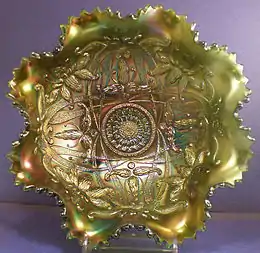Northwood Glass Company
The Northwood glass company was a manufacturer of art glass in various locations in the United States.
History
Harry Northwood who founded the company was the son of John Northwood a noted maker of English cameo glass.[1] He came to America in 1880 and worked at J. H. Hobbs, Brockunier and Company.[1] He worked as a glass etcher there from approximately 1881-1884.[2] He then worked for the La Belle glass company and during a strike there moved to Phoenix glass company in Pittsburgh, Pa.[2] He became a glass maker when he returned to La Belle about 1886.[2]
The original Northwood glass company was founded by Harry Northwood in 1887 in Martins Ferry, Ohio, and was moved to Ellwood City, Pennsylvania. But the company did not prosper in that location.[3] In 1895 he opened up the New Northwood glass company in a factory previously owned by the Indiana Glass company in Indiana, Pennsylvania. This factory joined National glass conglomerate in 1899.[3]
In 1902 Harry opened the Harry Northwood and company factory in Wheeling, West Virginia.[3][4] The factory had belonged to the J. H. Hobbs, Brockunier and Company.[1] It was here that he developed his formula for Carnival glass.[3]
Harry Northwood died in 1919. The company continued producing glass, but was closed in 1925.[5]
Colors
Golden Iris was the name of the first caravel glass treatment that Northwood developed in 1908.[3] It was known for its marigold color.[1] The other carnival glass treatments made by Northwood were Emerald, Azure, Florentine, Perl, and Pomona.[5] Carnival glass is identified by the color of the glass, not the color of the treatment. Base colors for Northwood were green, amethyst, and cobalt blue. Ice green, white, and ice blue were the names of the pastel colors.[1] Northwood also made custard, stretch and opalescent glass.[6]
Patterns

Some of the patterns were:
| Name | Years Produced | Description | Reference |
|---|---|---|---|
| Cherry and Cable | Early pattern made in very limited numbers. One of the first patterns to receive carnival treatment. | [7] | |
| Corn | Used on vases, looks like an ear of corn. There are two variations showing different leaves. | [8] | |
| Feathers | Used for vases, alternating herringbone and smooth panels. | [9] | |
| Grape and Cable | Northwood produced a large amount of this pattern. There were two variations of the pattern with one having more vine in the center. | [10] | |
| Three Fruits | 1910 | The pattern includes fruits and foliage. The Fenton glass also had a similar pattern. | [11] |
| Wishbone | This was used on bowls and plates of two different sizes, 8 and 10 inch. It is identified by its overlapping wishbone shapes. | [12] | |
Maker mark
The Northwood maker mark was a N inside of a circle.[13] Not all pieces carry the mark but it is seen most often on carnival glass items. L.G Wright also used a mark like it, but was forced to stop using it.[13]
See also
| Wikimedia Commons has media related to Northwood Glass Company. |
References
- "Vintage Northwood Glassware". collectorsweekly.com. Retrieved 29 March 2015.
- Wiggins, William Heacock, James Measell, Berry (1900). Harry Northwood, the early years, 1881-1900. Marietta, Ohio: Antique Publications. pp. 5 to 19. ISBN 0915410397.
- Schroy, Ellen T. (2008). Warman's carnival glass : identification and price guide (2nd ed.). Iola, Wis.: Krause. pp. 10–11. ISBN 978-0896895690.
- "A Brief History of Carnival Glass". A field guide to carnival glass. Northwood. Retrieved 29 March 2015.
- "CARNIVAL GLASS: THE FIRST DECADE". Kent State University. Archived from the original on 2 April 2015. Retrieved 29 December 2014.
- "Northwood". kovels.com. Retrieved 30 March 2015.
- David Doty. "Cherry and Cable, Northwood". The Field Guide To Carnival Glass. Retrieved 12 April 2015.
- David Doty. "Corn vases, Northwood". The Field Guide To Carnival Glass. Retrieved 12 April 2015.
- David Doty. "Feathers vases, Northwood". The Field Guide To Carnival Glass. Retrieved 12 April 2015.
- David Doty. "Grape and Cable Bowls and Plates, Northwood". The Field Guide To Carnival Glass. Retrieved 12 April 2015.
- David Doty. "Three Fruits, Northwood". The Field Guide To Carnival Glass. Retrieved 12 April 2015.
- David Doty. "Wishbone, Northwood". The Field Guide To Carnival Glass. Retrieved 11 April 2015.
- "Maker Marks". The Field Guide To Carnival Glass. Retrieved 10 April 2015.